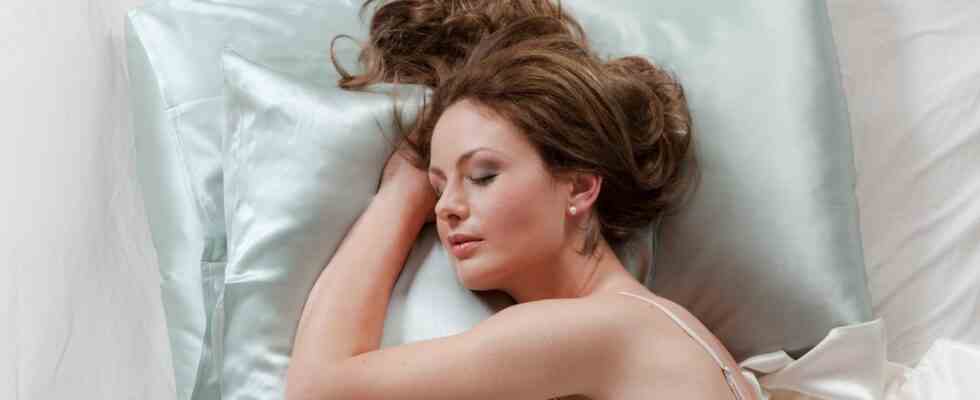fact check
Can a silk pillow really counteract wrinkles, split ends and hair breakage?
Can a silk pillow really help against hair breakage and wrinkles?
© LdF / Getty Images
Trends come and trends go. Sometimes they keep what they promise – and sometimes they turn out to be non-starters. We couldn’t help but wonder what’s behind the hype surrounding silk pillows. Do they really help against damaged hair?
The idea is not new, but it is modern: silk cushions are currently very trendy. However, not because of their attractive appearance. Rather, it is about the fact that the high-quality materials should counteract split ends and hair breakage. Many manufacturers even advertise that their products can reduce wrinkles on the face – but how do you come up with such an idea? Is this just a clever marketing campaign or does silk actually have a positive effect on our bodies? Two theories:
1. Theory: Silk pillows reduce wrinkles
Silk is a natural material produced by caterpillars. More specifically, it is in their cocoons that their larvae pupate, from which the fine fibers are obtained. Their structure as well as the PH value should be quite similar to our skin and hair, which is certainly one reason why the pillows have triggered a new beauty trend. But back to silk: not only is it hypoallergenic, it also repels house dust mites. This makes them quite attractive for allergy sufferers and asthmatics. But does it also help against wrinkles? The idea is that natural fibers (unlike cotton or polyester) are less absorbent. Which in turn should lead to the skin when sleeping on a Silk cover less moisture is removed. In addition, the smooth surface makes your skin less “crumpled” and therefore less prone to wrinkles. That sounds logical at first, but it is questionable how one should prove whether a silk pillow can actually slow down the formation of wrinkles? You would probably have to test that for years.
2. Theory: Silk pillows reduce split ends
Cotton is rougher than silk, which inevitably means that our hair is subjected to significantly more stress when sleeping on “rough” material. And they are therefore more prone to split ends. However, if you use a silk pillow, which has a similar structure to our hair, the less friction between the scalp and the cover should ensure less hair breakage. This is made possible by the smooth surface, over which your hair should literally glide – and thus be less likely to knot or tangle. For the same reason will also Silk hair ties touted as having an effect similar to silk pillows. So much for the theory. We think it is quite possible that the fine fibers can have a positive effect on our hair. However, every person (and their hair structure) is different, so the effect cannot and will not be the same for everyone. There is only one thing that helps to find out: just try it out. Maybe the pillow will turn out to be the ultimate miracle cure for split ends and hair breakage. Or you won’t notice any difference to ordinary covers.
The fact is that there is no scientific evidence for the effect of silk pillows. However, there is no question that silk fibers (especially in summer) have a cooling effect on our skin. And as a result, you sweat less while you sleep. So the investment would not be in vain.
Tip: How to properly clean silk pillows
Silk is particularly sensitive to high temperatures, so it is important to heed the following tips when washing:
In the washing machine
- You can find out whether a silk pillow is even suitable for the washing machine from the sewn-in care label. It also shows the recommended temperature that you can use for cleaning.
- Do not use ordinary detergent, use liquid one Detergent for delicates for sensitive textiles – such as silk. It was specially developed for low temperatures.
- Protect a silk pillow from other textiles that are washed with it by washing it in a fine mesh before each wash laundry net (including zipper) accommodate.
- Set a gentle cycle. Modern washing machines have an extra function for delicate materials such as silk. Also make sure that silk pillows are not spun too hard.
- After washing, remove the remaining moisture from the covers with a dry and clean towel. Never put a silk pillow in the dryer as it will not withstand the temperatures.
By hand
- Fill a bucket with lukewarm water that is no hotter than 30 degrees (alternatively, you can use the sink).
- Add some mild detergent for delicate fabrics to the water and distribute it briefly with your fingers.
- Soak the silk pillow in it for a few minutes before gently plunging it through the water.
- Replace the dirty water with fresh (lukewarm) water and rinse the silk pillow thoroughly.
- Draw the moisture out of the covers by placing a clean towel on top and pressing lightly.
- Place or hang the silk pillow on a drying rack in a non-sunny location until completely dry.
You might also be interested in:
This article contains so-called affiliate links. There is more information here.

